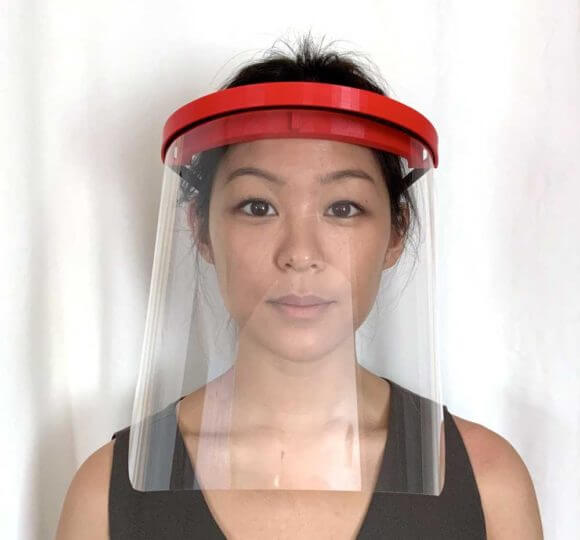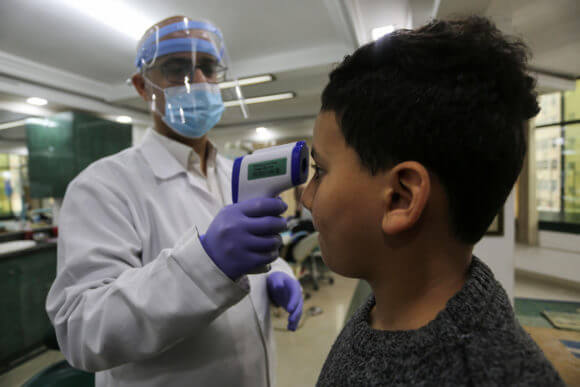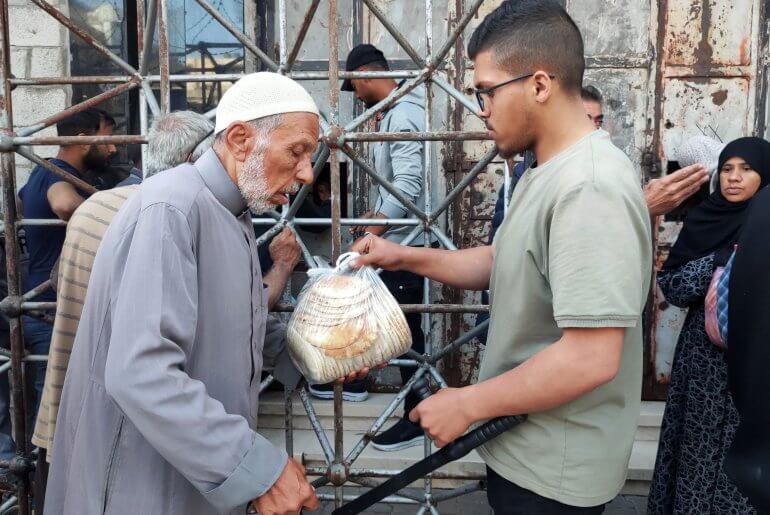Throughout the night, every two hours and 40 minutes Dr. Tarek Loubani wakes up from the blare of an alarm on his phone, lumbers down a set of stairs to his basement, and begins printing the next round of face shields. “The constant hum is my bedfellow,” he told me in a phone interview from his home in London, Ontario, describing the 13 3D printers churning out plastic guards that will be worn by healthcare workers treating COVID-19 patients. Two of the printers are on loan from a friend.
“This is place is like a beehive, a socially distant beehive,” Loubani said of his home turned factory. Shipments of raw material for the printers get dropped off out front, “someone had to drive to Toronto for mylar.”
Loubani, a 39-year-old Palestinian-Canadian emergency physician and associate professor at the University of Western Ontario, began using 3D printers to produce medical supplies seven years ago—but not in Canada, in the Gaza Strip. Under the Glia project, Loubani worked with medical teams in Gaza to produce thousands of stethoscopes and tourniquets, a life-saving medical device use stops the flow of blood to extremities during catastrophic injuries. Today, every EMT team in the Gaza Strip is equipped with tourniquets printed by Glia’s Gaza operation.
Loubani has practiced medicine in Gaza since 2012 in a series of humanitarian trips. In 2013 he traveled to Egypt alongside Canadian filmmaker John Greyson with the intention of continuing on to Gaza. The pair were detained by police in Cairo during a sweep on protesters supporting the then recently ousted president Mohammed Morsi. They spent 51 days in Egypt’s notorious Tora prison and were never charged with any crime.
In 2018 Loubani was shot in the leg while treating patients in the field during a protest near the border with Israel.

When the pandemic began, Glia in Gaza shifted gears and started printing face shields for local use. “They have so little so any piece of PPE is worth it,” Loubani said, the face shields, are “worth its weight in gold.”
“Currently in Gaza there is no adequate pipeline for frontline workers, and there is none coming as far we can tell,” Loubani said. “And while what is needed is an unrestricted lifting of the blockade on all medical personal and equipment, at the very least right now local promoting is trying to help where it can.”
Gaza, under an Egyptian and Israeli siege since 2007, is severely limited in the kind and quantity of its imports. “The PPE situation in Gaza is so dire that it’s hard to believe that frontline workers have a chance in this,” Loubani said.
In the current crisis the World Health Organization has spearheaded couriering testing kits and medical supplies, but the gaps are so extensive Gaza’s main method of slowing the spread of the coronavirus has been extensive quarantine practices. Over 2,000 returning travelers were been forced into 21 government-run quarantine facilities at schools and hotels. Another 3,000 were told to go into quarantine at home.
Last week the Israeli military began testing swabs taken in Gaza, processing around 50 tests a day. However, the deal was short-lived and came to an end after two days when the Israeli defense minister intervened.
Gaza had enough supplies to test 2,000 samples. By comparison, Mai al-Kaila, the Palestinian minister of health in Ramallah, told reporters today around 30,000 samples have been tested in the West Bank.
Over the last month, Gaza has intermittently run out of testing kits. There is only one lab capable of turning around test results.

In total 17 Palestinians in Gaza have tested positive for COVID-19, 12 have recovered and five are being treated in isolation rooms in a hospital. All of the cases were found inside of quarantine centers. A majority of those infected in Gaza are healthcare workers and security who became ill from quarantined patients. None of the cases are critical, but the concern from Gaza’s Ministry of Health is that testing capabilities are woefully under-equipped that the virus could be stealthily circulating, detectable once it overwhelms the healthcare system.
For the 2 million living in Gaza, there are only 87 intensive care unit beds with ventilators.
Since the pandemic Glia in Gaza produced 500 face shields and Loubani made 5,000 in his house. He has a grant to cover the expenses for another 40,000 that will be distributed to hospitals in the U.S. and Canada.
“3D printing is not the most efficient way to make 45,000 face shields,” he explained. “The way I look at free 3D printing is that there is this gap between sudden demand and production.
“We can make them in a couple of months whereas it will take a couple of months for traditional manufacturers to tool up,” he said. Loubani was able to put together the first prototype in two days. Glia as since made their design available for other 3D manufacturers to download.
Outside of printing, Loubani has stepped into providing technical expertise to stretch out the longevity of other protective gear. He advises hospitals on where to purchase and how to clean reusable respirators, more effective more stocked in Canada than the disposable N95.
“They look like painters mask, while the disposable ones look like a beefed-up surgical mask,” Loubani said.
“The filters are reusable for up to a year. And the filters cost C$10,” Loubani explained, referring to the price in Canadian dollars. “For C$45 you’re talking about outfitting an individual for a year.”




Lovely man, Tarek Loubani. He gave the Jim Graff Memorial lecture a year or two ago, speaking without notes. I’m pretty sure I sent Glia some money.